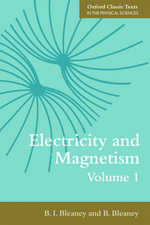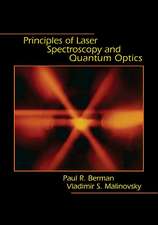Shock-Wave Phenomena and the Properties of Condensed Matter: Shock Wave and High Pressure Phenomena
Autor Gennady I. Kanel, Sergey V. Razorenov, Vladimir E. Fortoven Limba Engleză Paperback – 9 oct 2011
| Toate formatele și edițiile | Preț | Express |
|---|---|---|
| Paperback (1) | 1382.21 lei 43-57 zile | |
| Springer – 9 oct 2011 | 1382.21 lei 43-57 zile | |
| Hardback (1) | 1385.67 lei 43-57 zile | |
| Springer – 30 mar 2004 | 1385.67 lei 43-57 zile |
Din seria Shock Wave and High Pressure Phenomena
- 15%
 Preț: 651.67 lei
Preț: 651.67 lei - 24%
 Preț: 804.03 lei
Preț: 804.03 lei - 18%
 Preț: 2099.77 lei
Preț: 2099.77 lei - 18%
 Preț: 1111.97 lei
Preț: 1111.97 lei - 15%
 Preț: 645.28 lei
Preț: 645.28 lei - 18%
 Preț: 948.29 lei
Preț: 948.29 lei - 15%
 Preț: 532.38 lei
Preț: 532.38 lei - 18%
 Preț: 1235.25 lei
Preț: 1235.25 lei - 18%
 Preț: 1132.65 lei
Preț: 1132.65 lei - 18%
 Preț: 1228.96 lei
Preț: 1228.96 lei -
 Preț: 397.01 lei
Preț: 397.01 lei - 18%
 Preț: 949.10 lei
Preț: 949.10 lei - 15%
 Preț: 634.32 lei
Preț: 634.32 lei - 18%
 Preț: 1546.86 lei
Preț: 1546.86 lei - 24%
 Preț: 1040.54 lei
Preț: 1040.54 lei - 15%
 Preț: 642.03 lei
Preț: 642.03 lei - 18%
 Preț: 892.90 lei
Preț: 892.90 lei - 20%
 Preț: 560.55 lei
Preț: 560.55 lei - 18%
 Preț: 1390.73 lei
Preț: 1390.73 lei - 18%
 Preț: 947.50 lei
Preț: 947.50 lei - 18%
 Preț: 957.44 lei
Preț: 957.44 lei - 18%
 Preț: 1126.69 lei
Preț: 1126.69 lei -
 Preț: 384.70 lei
Preț: 384.70 lei - 15%
 Preț: 649.39 lei
Preț: 649.39 lei -
 Preț: 392.21 lei
Preț: 392.21 lei - 15%
 Preț: 596.36 lei
Preț: 596.36 lei - 18%
 Preț: 1554.72 lei
Preț: 1554.72 lei - 18%
 Preț: 1228.29 lei
Preț: 1228.29 lei - 15%
 Preț: 644.30 lei
Preț: 644.30 lei - 18%
 Preț: 891.80 lei
Preț: 891.80 lei - 18%
 Preț: 951.14 lei
Preț: 951.14 lei - 15%
 Preț: 534.82 lei
Preț: 534.82 lei -
 Preț: 391.79 lei
Preț: 391.79 lei
Preț: 1382.21 lei
Preț vechi: 1685.62 lei
-18% Nou
Puncte Express: 2073
Preț estimativ în valută:
264.49€ • 276.84$ • 220.14£
264.49€ • 276.84$ • 220.14£
Carte tipărită la comandă
Livrare economică 31 martie-14 aprilie
Preluare comenzi: 021 569.72.76
Specificații
ISBN-13: 9781441919168
ISBN-10: 1441919163
Pagini: 340
Ilustrații: XIII, 322 p. 52 illus.
Dimensiuni: 155 x 235 x 18 mm
Greutate: 0.48 kg
Ediția:Softcover reprint of the original 1st ed. 2004
Editura: Springer
Colecția Springer
Seria Shock Wave and High Pressure Phenomena
Locul publicării:New York, NY, United States
ISBN-10: 1441919163
Pagini: 340
Ilustrații: XIII, 322 p. 52 illus.
Dimensiuni: 155 x 235 x 18 mm
Greutate: 0.48 kg
Ediția:Softcover reprint of the original 1st ed. 2004
Editura: Springer
Colecția Springer
Seria Shock Wave and High Pressure Phenomena
Locul publicării:New York, NY, United States
Public țintă
ResearchCuprins
1 Introduction to the Theoretical Background and Experimental Methods of Shock Physics.- 2 Elastic-Plastic Response of Solids Under Shock-Wave Loading.- 3 Yield and Strength Properties of Metals and Alloys at Elevated Temperatures.- Chapter4 Behavior of Brittle Materials under Shock-Wave Loading.- 5 Two Examples of Spatially Resolved Shock-Wave Tests.- 6 Polymorphic Transformations and Phase Transitions in Shock-Compressed Solids.- 7 Equations of State and Macrokinetics of Decomposition of Solid Explosives in Shock and Detonation Waves.- 8 Shock Waves and Extreme States of Matter.
Textul de pe ultima copertă
Strong shock waves present unique opportunities for investigations in the fields of physics of condensed matter, thermophysics, physics of strength and plasticity, and chemical physics under conditions of the highest possible rates of deformation, and high pressures and temperatures. The physics of shock waves in condensed matter deal with pressures from ~100 MPa to several hundreds of GPa (and up to ten TPa in some unique experiments), temperatures up to tens of thousands of K, and durations of load application from nanoseconds to a few microseconds. Behavior of a material under these extreme conditions often differs radically from expectations based on quasistatic observations. As an example, observed anomalous temperature dependencies of the strength properties of some metals were not predicted by theories.
The investigations of shock-wave phenomena in condensed matter that are discussed in this book are stimulated by the necessity to develop methods for predicting effects of explosions, high-velocity collisions, and other sources of intense dynamic loading of materials and structures. In the modern view, complete predictability is achieved when computers can accurately simulate processes of interest. The simulations require development of thermophysical equations of state and constitutive relationships that describe processes of inelastic deformation and fracture, polymorphic transformations, chemical reactions, melting, vaporization, ionization, and other phenomena observed under these conditions.
Systematic discussions of various aspects of thermomechanical behavior of solid materials of different classes when subjected to shock-wave loading comprise the main part of this book. It provides an account of recent Russian work in this field that is unique in its balanced coverage of theoretical, experimental, and computational results.
The discussions include a comprehensive analysis of:
The structure of compression and rarefaction waves in solids, experimental data on the dynamic yield and tensile strengths of metals and alloys at normal and elevated temperatures, and constitutive relationships that describe high-rate yielding
Static and dynamic compressive deformation and fracture of brittle materials, and failure-wave phenomena
Shock induced polymorphic transformation, melting, and vaporization
Explosive initiation and detonation phenomena, with emphasis on macrokinetics of chemical energy release
Physics of the most extreme states of matter accessible by shock compression.
The investigations of shock-wave phenomena in condensed matter that are discussed in this book are stimulated by the necessity to develop methods for predicting effects of explosions, high-velocity collisions, and other sources of intense dynamic loading of materials and structures. In the modern view, complete predictability is achieved when computers can accurately simulate processes of interest. The simulations require development of thermophysical equations of state and constitutive relationships that describe processes of inelastic deformation and fracture, polymorphic transformations, chemical reactions, melting, vaporization, ionization, and other phenomena observed under these conditions.
Systematic discussions of various aspects of thermomechanical behavior of solid materials of different classes when subjected to shock-wave loading comprise the main part of this book. It provides an account of recent Russian work in this field that is unique in its balanced coverage of theoretical, experimental, and computational results.
The discussions include a comprehensive analysis of:
The structure of compression and rarefaction waves in solids, experimental data on the dynamic yield and tensile strengths of metals and alloys at normal and elevated temperatures, and constitutive relationships that describe high-rate yielding
Static and dynamic compressive deformation and fracture of brittle materials, and failure-wave phenomena
Shock induced polymorphic transformation, melting, and vaporization
Explosive initiation and detonation phenomena, with emphasis on macrokinetics of chemical energy release
Physics of the most extreme states of matter accessible by shock compression.

















